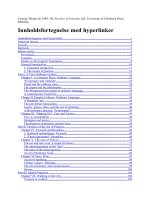university alabama press the archaeology of town creek nov 2007
Bạn đang xem bản rút gọn của tài liệu. Xem và tải ngay bản đầy đủ của tài liệu tại đây (1.63 MB, 150 trang )
The Archaeology of Town Creek
A Dan Josselyn Memorial Publication
The Archaeology
of Town Creek
EDMOND A. BOUDREAUX
THE UNIVERSITY OF ALABAMA PRESS
Tuscaloosa
Copyright © 2007
The University of Alabama Press
Tuscaloosa, Alabama 35487-0380
All rights reserved
Manufactured in the United States of America
Typeface: Minion
∞
The paper on which this book is printed meets the minimum requirements of American
National Standard for Information Sciences- Permanence of Paper for Printed Library
Materials, ANSI Z39.48-1984.
Library of Congress Cataloging- in- Publication Data
Boudreaux, Edmond A.
The archaeology of Town Creek / Edmond A. Boudreaux.
p. cm.
Includes bibliographical references and index.
ISBN-13: 978-0-8173-1587-0 (cloth : alk. paper)
ISBN-10: 0-8173-1587-X
ISBN-13: 978-0-8173-5455-8 (pbk. : alk. paper)
ISBN-10: 0-8173-5455-7
1. Town Creek Site (N.C.) 2. Mississippian culture— North Carolina. 3. Indians of North
America— North Carolina— Antiquities. 4. Excavations (Archaeology)—North Carolina.
5. North Carolina— Antiquities. I. Title.
E78.N74B68 2007
975.6′74—dc22
2007009465
For Christy
Contents
List of Illustrations ix
Acknowledgments xi
1. Mississippian Public Architecture, Leadership, and the Town
Creek Community 1
2. Architectural Analysis 15
3. Occupational History of Town Creek 44
4. Mortuary Analysis 66
5. Vessel Analysis 95
6. Conclusions 105
References 117
Index 133
Illustrations
FIGURES
1.1. The location of Town Creek in relation to other
Mississippian sites 4
1.2. Archaeological features at Town Creek 5
1.3. The spatial extent of the South Appalachian Mississippian
tradition 7
1.4. Pee Dee culture and related sites 8
1.5. Town Creek and nearby Pee Dee sites 10
1.6. Topographic map of the Town Creek mound 11
2.1. Identifi ed architectural elements at Town Creek 16
2.2. Identifi ed structures and burial clusters at Town Creek 17
2.3. Histogram of burial density by structure 18
2.4. Histogram of area of all circular structures 20
2.5. Enclosed Circular Structures 21
2.6. Small Circular Structures 22
2.7. Histogram of the number of burials in circular structures 23
2.8. Large Rectangular Structures 24
2.9. Earth- embanked Structures 25
2.10. Medium Rectangular Structures 27
2.11. Small Rectangular Structures 28
2.12. Identifi ed architectural elements in the mound area 29
2.13. Earth- embanked wall and postholes at northeastern corner of
Structure 23a, 1937 30
2.14. Mound profi le 32
2.15. Structures 45a and 45b on the mound summit 35
2.16. Structures 46a and 46b on the mound summit 36
2.17. Identifi ed architectural elements in the eastern part of the site 39
2.18. Identifi ed architectural elements in the central part of the site 41
3.1. Structure 18 and Burial Cluster 40 47
3.2. Schematic map of possible Teal phase architectural elements 50
3.3. Schematic map of the early Town Creek phase occupation 51
3.4. Schematic map of the terminal early Town Creek phase
occupation 52
3.5. Histogram of burial density in early Town Creek phase structures 54
3.6. Schematic map of the late Town Creek–Leak phase occupation 56
3.7. Histogram of late Town Creek- Leak phase structures by burial
density 58
3.8. Schematic map of the late Leak phase occupation 61
3.9. Schematic map of the Caraway phase occupation 63
4.1. Burials in Small Circular Structures 71
4.2. Burials associated with Structures 45a and 45b on the mound
summit 74
4.3. Burials associated with Structures 46a and 46b on the mound
summit 76
4.4. Burials associated with Enclosure 1 and Structure 51 78
4.5. Burials in Enclosed Circular Structures 79
4.6. Burials in Large Rectangular Structures 81
4.7. Histograms of NAT for early Town Creek and late Town
Creek–Leak phase burials with grave goods 90
5.1. Pee Dee vessel types 98
5.2. Boxplot comparing jar rim diameters among contexts 101
TABLES
1.1. Calibrated and uncalibrated dates for Mississippian phases in
the Town Creek area 9
4.1. Burials by time period and structure type 72
5.1. Percentage of vessel categories by context 99
x / Illustrations
Acknowledgments
The efforts of many people are represented in this book, and I am grate-
ful to them all. I want to thank everyone who has made the Town Creek site
and its archaeological collection’s incredible resources available for learning
about Native Americans in the Southeast. Archie Smith and the staff at Town
Creek Indian Mound State Historic Site have been helpful and encouraging
throughout my research. Steve Davis of the Research Laboratories of Archae-
ology at the University of North Carolina put an incredible amount of effort
into organizing the materials from Town Creek, especially the photographs
and the site map. The occupational history of Town Creek could not have
been investigated without Steve’s previous work. I want to acknowledge the
numerous fi eld workers, lab workers, and on- site supervisors who ever worked
at Town Creek or with its collections. Since 1937, much effort has gone into
excavating, processing, and curating artifacts from the site. I was very fortu-
nate to walk into a situation where I had access to an organized, well- curated
collection that included tens of thousands of labeled ceramics and a number
of reconstructed ceramic vessels. I also want to acknowledge Joffre L. Coe, the
man who envisioned and oversaw long- term research at the site. Town Creek
is an integral part of his legacy.
This book has benefi ted from the insights, suggestions, and ideas of many
people. I want to thank Steve Davis, Kandi Hollenbach, Jon Marcoux, Mintcy
Maxham, Brett Riggs, Chris Rodning, Vin Steponaitis, Trawick Ward, and
Greg Wilson for the many, many ways in which they helped me during my
time at the University of North Carolina (and beyond). I also want to thank
the reviewers, Barry Lewis and Lynne Sullivan, and the staff of The Univer-
sity of Alabama Press for all their excellent suggestions. This is a greatly im-
proved work thanks to the efforts of all these folks.
The research presented here received funding from several sources. The
Center for the Study of the American South at the University of North Caro-
lina provided a grant that partially supported the production of a geographic
information systems map of Town Creek. Grants from the North Carolina Ar-
chaeological Society and the Timothy P. Mooney Fellowship of the Research
Laboratories of Archaeology both went to obtaining radiocarbon dates. There
are few funding sources for collections- based research in the Southeast, and I
want to thank these institutions for the support they were able to provide.
My family has been there for me throughout this process. My parents,
Edmond and Virginia Boudreaux, have always done whatever they could to
help us along our way. My children— Anthony, Christian, and Claire Anne—
have provided joy, frustration, and diversion. Finally, there is Christy. There
is not much I could do without her.
xii / Acknowledgments
The Archaeology of Town Creek
1
Mississippian Public Architecture, Leadership,
and the Town Creek Community
Numerous Mississippian societies developed across the southeastern United
States beginning around a.d. 1000 (Smith 1986; Steponaitis 1986). The Mis-
sissippian rubric, which covers over 800 years and virtually all of southeast-
ern North America, encompasses a great deal of variation regarding material
culture, physiography, settlement patterns, and political organization (Griffi n
1967, 1985a:190; Smith 1978). Generally, Mississippian societies have been as-
sociated with relatively large populations, the increased importance of maize
as a dietary staple, the construction of permanent towns and ceremonial cen-
ters, extensive trade networks, the appearance and elaboration of village- level
positions of authority, and the placement of public buildings on earthen plat-
form mounds (Griffi n 1985a:63; Smith 1986:56–63; Steponaitis 1986:388–391).
The appearance of Mississippian platform mounds has been taken as an in-
dication that the communities who built them possessed certain social and
political attributes that communities without mounds lacked. At the regional
scale, sites with mounds generally are seen as social and political centers
that integrated contemporaneous nonmound sites into settlement systems.
At the community level, mounds are often seen as marking both increased
vertical social differentiation and the centralization of political power (An-
derson 1994:80; Hally 1999; Lewis and Stout 1998:231–232; Lindauer and
Blitz 1997; Milner and Schroeder 1999:96; Muller 1997:275–276; Steponaitis
1978, 1986:389–392).
Platform mounds have been a part of Southeastern Native American com-
munities since at least 100 b.c. (Jeffries 1994; Knight 1990; Lindauer and Blitz
1997:172). They were associated with a number of different activities and were
built by societies that were economically, politically, and socially organized
in very different ways (Blitz 1993a:7; Lindauer and Blitz 1997). One signifi -
cant development occurred around a.d. 400, when leaders in some commu-
nities began to place their houses on top of earthen mounds— an act that has
been interpreted as an attempt to legitimize personal authority by a commu-
2 / Chapter 1.
nity leader through the appropriation of a powerful, traditional, community-
oriented symbol (Milanich et al. 1997:118; Steponaitis 1986:386). These early
acts were followed in subsequent centuries by three major changes in political
leadership that are thought to refl ect the institutionalization and centraliza-
tion of political power within Mississippian chiefl y authority. First, while
leadership positions in Woodland societies probably were attained through
achievement (Steponaitis 1986:383), theoretically being open to individuals
from any family, Mississippian leaders increasingly were drawn from high-
ranking families in the community (Blitz 1993a:12; Knight 1990:17). Second,
unlike Woodland societies in which it seems that charismatic individuals
built and maintained a group of followers, Mississippian societies had offi ces
of leadership that existed independently of any one individual (Hally 1996;
Scarry 1996:4; Steponaitis 1986:983). Third, while earlier societies are thought
to have made political decisions through councils in which a number of com-
munity leaders reached consensus, community- level decisions in Mississip-
pian societies seem to have been made by a much smaller subset of commu-
nity members; that is, political power became centralized (Pauketat 1994:168;
Scarry 1996:11; Steponaitis 1986:388; Wesson 1998:114; but see Blitz 1993a:7
and Muller 1997:83).
It has been proposed that changes in leadership that occurred during the
Mississippian period— namely, the centralization of political power— are re-
fl ected in concomitant changes in public architecture (Emerson 1997:250;
Lewis and Stout 1998:231). Within the regional variant of Mississippian cul-
ture known as South Appalachian Mississippian (Ferguson 1971), platform
mounds at a number of sites were preceded by a distinctive type of building
called an earthlodge— a structure with earth- embanked walls and an entrance
indicated by short, parallel wall trenches (Crouch 1974; Rudolph 1984). The
best- known example is the building found beneath Mound D at Ocmulgee in
Georgia (Fairbanks 1946; Larson 1994:108–110). It is a circular structure with
a central hearth and a bench with individual seats along its wall. Based on
analogy with the council houses of historic Indians (see Hudson 1976:218–
226) and perhaps using the Ocmulgee structure as a prototype, earthlodges
in the Southeast have been interpreted as places where a council of commu-
nity leaders came together to make decisions based on consensus (Anderson
1994:120, 1999:220; DePratter 1983:207–208; Wesson 1998:109).
In contrast to the more inclusive function proposed for premound earth-
lodges, it has been argued that access to the buildings on top of Mississippian
platform mounds was limited to a much smaller subset of the community
(Anderson 1994:119; Blitz 1993a:92; Brown 1997:479; but see Blitz 1993a:184).
Among historically observed Mississippian groups, mound summits contained
the residences and ritual spaces of the social and political elite (i.e., chiefs and
Mississippian Public Architecture / 3
their families) (Lewis et al. 1998:17; Steponaitis 1986:390). In contrast, non-
elites had limited access— both physically and visually— to mound summits
(Holley 1999:30) or were excluded outright (Kenton 1927:427; McWilliams
1988:92). A compelling argument has been made that mounds were the seats
and symbols of political power within Mississippian societies (Hally 1996,
1999). If this was the case and if ground- level earthlodges were more ac-
cessible than mound- summit structures, then access to leaders and leader-
ship may have decreased over time. Thus, the sequence of change for public
architecture during the Mississippian period may refl ect a centralization of
political power over time (Anderson 1994:119–120, 1999:220; DePratter 1983:
207–208; Rudolph 1984:40).
The idea that changes in public architecture refl ect society- wide changes
in relationships among individuals and groups seems plausible (see Adler and
Wilshusen 1990:141; McGuire and Schiffer 1983:283). However, this relation-
ship has not been extensively tested against the Mississippian archaeological
record. While changes in public architecture have been documented at nu-
merous Mississippian sites, our ability to explore concomitant social and po-
litical change has been hindered in many cases by the limited excavation of
contemporaneous contexts within the same community. In the research pre-
sented here, some of the community- level assumptions attributed to the ap-
pearance of Mississippian mounds are tested against the archaeological record
of the Town Creek site— the remains of a town located at the northeastern
edge of the geographic extent of Mississippian sites (Figure 1.1). In particular,
the archaeological record of Town Creek is used to test the idea that the ap-
pearance of Mississippian platform mounds was accompanied by the cen-
tralization of political authority in the hands of a powerful chief. Excavations
at the Town Creek archaeological site have shown that the public architec-
ture there follows the earthlodge- to- platform- mound sequence that is well
known across the South Appalachian subarea of the Mississippian world (Coe
1995:65–82; Ward and Davis 1999:127). Work at Town Creek also has docu-
mented a majority of the site’s nonmound architecture (Figure 1.2). The clear
changes in public architecture coupled with the extensive exposure of the
site’s domestic sphere make Town Creek an excellent case study for examining
the relationship among changes in public architecture and leadership within
a Mississippian society.
CHIEFDOMS AND CHIEFS
It is clear from the ethnohistoric and archaeological records that chiefdom-
level societies existed across the Southeast from the tenth through the eigh-
teenth centuries (Blitz 1993a:6; Knight 1990:1; Steponaitis 1986:391). It is gen-
4 / Chapter 1.
erally accepted that Southeastern chiefdoms consisted of multiple settlements
that were integrated through shared social and political institutions (Blitz
1999:579). It is also accepted that there was an ascriptive element to the fi lling
of leadership positions within these societies (Blitz 1999:579; Knight 1990:19).
Beyond these two general points of agreement, however, there currently is a
great deal of debate about the nature of Mississippian societies. The preva-
lent interpretation has been that the relationships among settlements within
Southeastern chiefdoms were hierarchical (Anderson 1994:118; Emerson 1997;
Peebles and Kus 1977:440; Smith 1978:495; Steponaitis 1978:420), but ex-
planations that recognize the possibility that individual settlements were
more autonomous have recently been offered (Blitz 1999; Maxham 2004).
Chiefs in Southeastern societies have been viewed as powerful individuals
with a great deal of economic and political control (Emerson 1997:249–260;
Pauketat 1992:40, 1994:168; Welch 1991:180). However, alternative interpre-
tations signifi cantly downsize their control over people and resources (Blitz
1993a:184; Cobb 1989:89, 2000:191; Milner 1998:176; Muller 1997:56; Wilson
2001:125).
There are a number of different ways to investigate Mississippian chief-
doms. The approach that was followed when the chiefdom concept was fi rst
introduced to anthropology was one in which ethnography and ethnohistory
were used to construct the attributes that constituted a model chiefdom (see
Figure 1.1. The location of Town Creek in relation to other Mississippian sites.
Mississippian Public Architecture / 5
Carneiro 1981:38). Within this method, the documentation of one or more of
these attributes archaeologically is then used to infer the presence of the oth-
ers, even if these attributes are not demonstrated (see Knight 1990:2). This ap-
proach was used in some of the initial studies of chiefdoms in the Southeast
(see Knight 1990:2), and it has recently been used to propose organizational
variation among chiefdoms worldwide (e.g., Blanton et al. 1996). The terms
“chiefdom” and “chief” will for the most part be conspicuously absent in the
research presented here. These concepts are useful when clearly defi ned and
consistently applied. Indeed, in all likelihood, the Town Creek site represents
the political and ceremonial center of a simple chiefdom (see Blitz 1993a:12–
Figure 1.2. Archaeological features at Town Creek.
6 / Chapter 1.
13). For this research, though, these terms are not critical and may actually be
impediments because of their associated intellectual baggage. Chiefdoms, by
defi nition, are regional entities consisting of multiple communities under the
political authority of a chief (Carneiro 1981:45; Earle 1991:1). The data pre-
sented here regarding social and political change all come from a single site,
Town Creek. Although it would be fascinating to explore regional- level data
for the Pee Dee River Valley in the vicinity of Town Creek, such a study has
not been conducted at this time. Thus, it would be misleading and of little
interpretive value to talk about “the Town Creek chiefdom” when such an en-
tity has not been defi ned (see Flannery 1999:45). I will instead discuss the
Town Creek community. The individuals who occupied preeminent political
positions at Town Creek will be referred to as community leaders, although
a number of expressions would have been appropriate. The term “chief” has
been avoided partly because it has come to be associated with ideas of po-
litical and economic power as well as manipulative and personally aggrandiz-
ing behavior (see Earle 1997). While these attributes and activities may have
been a necessary part of political leadership in many Mississippian societies,
they certainly did not exist to the same degree in them all.
THE MISSISSIPPIAN CULTURE HISTORY
OF TOWN CREEK
A South Appalachian province has been recognized as a large- scale variant
within the Mississippian Southeast based on the occurrence of a predomi-
nantly complicated- stamped and non- shell- tempered ceramic tradition (Cald-
well 1958:34; Ferguson 1971:7–8; Griffi n 1967:190). The South Appalachian
Mississippian tradition has been divided into three broad cultural units—
Etowah (a.d. 1000–1200), Savannah (a.d. 1200–1350), and Lamar (a.d. 1350–
1550)—that crosscut the numerous phases that constitute more localized cul-
tural sequences (Anderson 1994; Anderson et al. 1986; Ferguson 1971; Hally
1994; Hally and Langford 1988; Hally and Rudolph 1986; King 2003; Rudolph
and Hally 1985; Wauchope 1966). The spatial extent of the South Appala-
chian Mississippian tradition is essentially the eastern half of the Southeast,
containing Georgia, South Carolina, and contiguous portions of Alabama,
Florida, North Carolina, and Tennessee (Figure 1.3) (Ferguson 1971:7). The
co- occurrence at Town Creek of a predominantly complicated- stamped ce-
ramic tradition and a substructural platform mound places it within the
South Appalachian Mississippian tradition (see Ferguson 1971:261).
The South Appalachian Mississippian construct contains a great deal of
ceramic variation, and a number of local ceramic series and sequences have
been defi ned within this broader tradition (Hally 1994:Figure 14.1; Williams
Mississippian Public Architecture / 7
and Shapiro 1990:30–77). The Pee Dee series, which includes the Mississip-
pian pottery found at Town Creek and surrounding sites, is one of these lo-
cal variants. The geographic extent of Pee Dee culture, indicated by sites with
a predominance of pottery from the Pee Dee series, as it is currently under-
stood includes portions of south- central North Carolina and northeastern
South Carolina (Figure 1.4) (Anderson 1982:313; Cable; DePratter and Judge
1990:56–58; Judge 2003; Kelly 1974; Mountjoy 1989; Oliver 1992; South 2002;
Stuart 1975; Trinkley 1980). The development of the Pee Dee concept, both
as an archaeological culture and a ceramic series, has been closely tied to the
work of Joffre Coe. Coe (1952:308–309) gave the fi rst defi nition of the Pee
Dee focus based on his excavations at Town Creek, and he included a brief
discussion of the Pee Dee pottery series in his landmark publication Forma-
tive Cultures of the Carolina Piedmont (Coe 1964:33). Later, J. Jefferson Reid,
one of his students, produced the fi rst detailed description of Pee Dee pottery
from Town Creek (Reid 1967).
The Town Creek ceramic chronology fi ts comfortably within the South
Appalachian Mississippian ceramic tradition (see Ferguson 1971). There are
surface treatments and rim modes in the Town Creek–area assemblages that
allow us to relate this area— under the rubrics of Etowah, Savannah, and La-
mar cultures— to numerous other Mississippian sites located in the eastern
Figure 1.3. The spatial extent of the South Appalachian Mississippian tradition (based on
Ferguson 1971:Map 1).
8 / Chapter 1.
part of the Southeast. Oliver (1992) proposed a sequence of phases— Teal,
Town Creek, and Leak— for the Mississippian period in the vicinity of Town
Creek based on his excavations at the Leak and Teal sites. The ceramic con-
tent of these phases has been refi ned based on seriations of 11 assemblages
from the Leak, Payne, Teal, and Town Creek sites (Boudreaux 2005:55–59).
The temporal spans of the Teal, Town Creek, and Leak phases as presented by
Oliver also have been modifi ed based on a consideration of 15 calibrated (see
Stuiver et al. 2005) and uncalibrated radiocarbon dates (Boudreaux 2005:75–
80) from these four sites (Table 1.1) (Eastman 1994; Mountjoy 1989; Oliver
1992; Reid 1967).
While Town Creek ceramics are similar to South Appalachian Mississip-
pian assemblages found to the south and west, the distinctions between Town
Creek pottery and what is found to the north and east are striking. Detailed
chronologies developed for the central and northern Piedmont in North Caro-
lina (Ward and Davis 1993, 1999) indicate that these areas, located less than
200 miles from Town Creek, exhibit very different yet contemporaneous ce-
ramic traditions that lack the distinctive rim treatments and complicated
Figure 1.4. Pee Dee culture and related sites.
Mississippian Public Architecture / 9
stamping found at Town Creek. The ceramic traditions in the Sandhills and
Coastal regions of North Carolina to the east are equally distinct from that
found at Town Creek (Ward and Davis 1999). The systematic survey of nearly
100,000 acres of the Fort Bragg military reservation, located approximately
40 miles east of Town Creek, has produced only a handful of complicated-
stamped pottery (Joseph Herbert, personal communication 2005; Irwin et al.
1999:82). As Coe (1952) emphasized in his fi rst publication on Pee Dee cul-
ture, Town Creek is clearly distinctive in the North Carolina Piedmont, and it
is one of the northeasternmost Mississippian sites in the Southeast.
PREVIOUS RESEARCH AT TOWN CREEK
Town Creek is located in the southern Piedmont of North Carolina, opposite
a bend of the Little River near the town of Mt. Gilead in Montgomery County
(Figure 1.5). It has fi gured prominently in North Carolina archaeology since
the late 1930s. According to Ward and Davis (1999:131): “The Town Creek
site, like a powerful magnet, has drawn the attention of archaeologists for over
sixty years. With only mild hyperbole, it could be said that the mound on the
banks of the Little River has been the center of the archaeological universe
in the southern North Carolina Piedmont.”
Fieldwork began at Town Creek in 1937 and continued intermittently un-
til 1983 (Griffi n 1985b:297). In 1937, Coe, then an undergraduate at UNC,
stopped taking classes in order to direct the fi rst excavations at Town Creek
(Ward and Davis 1999:122). The site was then called the Frutchey Mound,
after the landowner who had recently donated the mound and some adjoin-
ing land to the state (Coe 1995:12). The excavation project was approved to
use Works Progress Administration labor (see Coe 1940), but eligible indi-
Table 1.1. Calibrated and uncalibrated dates (a.d.) for
Mississippian phases in the Town Creek area
Phase Calibrated Uncalibrated
Leak 1300–1500 1300–1550
Late 1400–1550 1450–1550
Early 1300–1400 1300–1450
Town Creek 1150–1300 1050–1300
Late 1250–1300 1250–1300
Early 1150–1250 1050–1250
Teal 1000–1150 900–1050
10 / Chapter 1.
viduals not assigned to other projects were scarce in Montgomery County
(Coe 1995:14). Thus, the crew sizes at Town Creek were relatively small, un-
like many other depression- era excavation projects that received labor from
federal relief programs (see Ferguson 1995:xiii; Lyon 1996).
As was the practice at the time, the mound area (Mg
0
2) was given a differ-
ent site number than the remainder of the site (Mg
v
3) when fi eldwork began
in 1937. The fi rst fi eld seasons at Town Creek concentrated on the mound
and the area immediately surrounding it. In 1937, the mound was about 12 ft
high, measuring about 100 ft north- south and 90 ft east- west. Although the
core of the mound was relatively intact, relic collectors in the late 1920s had
severely damaged its eastern part (Figure 1.6). One looting episode included
the use of mules and a drag pan to remove the eastern portion of the mound
down to subsoil (Coe 1995:8). Much of the 1937 fi eld season was spent clean-
ing up this earlier damage and recording the stratigraphy of the exposed face
of the mound (Coe 1995:15). Most of the mound was excavated prior to 1940.
Figure 1.5. Town Creek and nearby Pee Dee sites.









